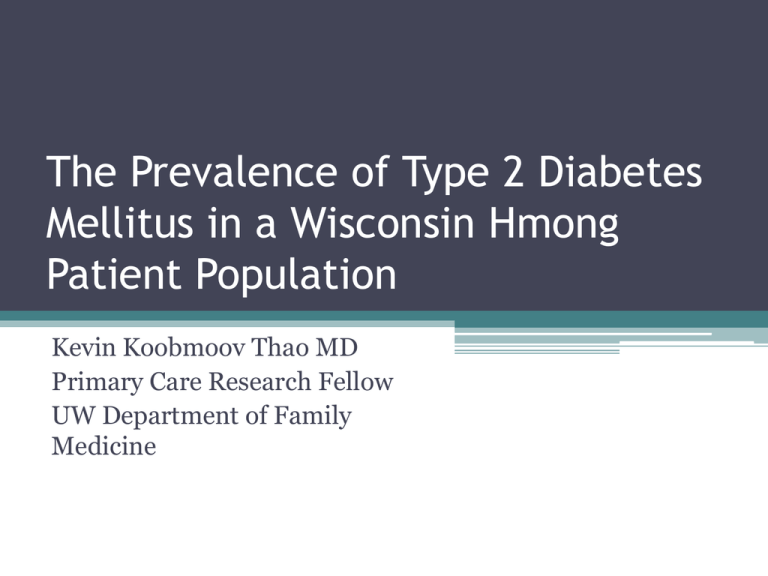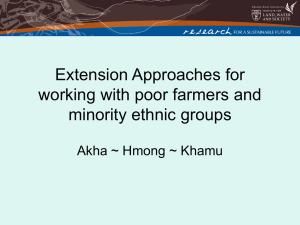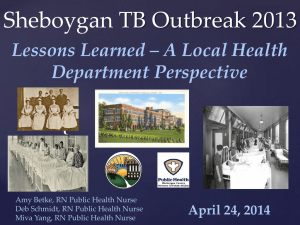
The Prevalence of Type 2 Diabetes
Mellitus in a Wisconsin Hmong
Patient Population
Kevin Koobmoov Thao MD
Primary Care Research Fellow
UW Department of Family
Medicine
Outline
•
•
•
•
The Wisconsin Hmong
Diabetes in the Hmong population
Results
Next Steps
Population Totals
• 33,791 Hmong living in Wisconsin according to
2000 US Census data - .63% of the states total
population
• 57.1% of the Hmong are under 18 years old and
2/3 are under 24
• Average size for Hmong family 6.4 persons
• This population has experienced a 100% growth
since the 1990 census.
The Prevalence of Type 2 Diabetes Mellitus in a
Wisconsin Hmong Patient Population
Purpose: To compare the prevalence of
diabetes in the Hmong subpopulation of
the University of Wisconsin Department
of Family Medicine ambulatory care
population to non-Hispanic white
patients.
The UW Clinical-Public Health Data
Exchange Pilot
• Extraction of patient electronic medical records
of the UW DFM clinic population from years
2007-2009
• Outpatient visits to UW DFM clinics
documented with the EpicCare© EMR
• Project Objective: To link patient electronic
health records with public health databases to
facilitate multidimensional investigations of
population health.
Multi-Level Modeling and Data Mining of Disease
Risk, Disparity, and Health Outcome Quality
Outcomes =
Asthma
Diabetes
CVD / CHF
Immunizations
Obesity
Hypertension
Smoking
Alcohol
A1c level
LDL
Patient
Factors +
Age
Gender
Race/ethnicity
Co-morbidities
Medications
Language
Insurance
Urban / Rural
Clinician
Factors +
Age
Gender
Certifications
Graduation
date
Years of practice
Clinic
Factors +
Location
Capabilities
Processes
Census Block Group
HDL
BP
Hospitalizations
Community
Factors
Census Block Group:
Poverty
Education level
Built environment:
Traffic
Recreation / parks
Safety / crime
Psycho-demographics
Restaurant mix
Fast food sales
Fresh fruit & vegetable sales /
consumption
Public Health Programs
Health Care -Process
factors
(e.g, time to repeat
follow-up)
Electronic Health Record & Hospitalization Data
Census / ESRI Data + PH Information
Systems
Study Data Selection
• EMR extract data contains demographic and
health information on 192,201 unique
ambulatory care patients
• 2.5 million clinical encounters
• Patient Confidentiality was protected by removal
of identifying information before extraction
▫ Name, exact birth date, SS#, exact address, HIV
diagnosis information, Medical Record Numbers
Population Selection by Race,
Ethnicity and Language
Race/Ethnicity
Language
Non-Hispanic
White
157,526
(82.0%)
Comparison Group
Non-Hispanic
White
157,526
(82.0%)
Total patient
Population
192,201
Selected Group
Non-Hispanic
Asian 5743
(2.99%)
Hmong 611
(0.32%)
Hmong 611
(0.32%)
Variable Definitions
• Race/Ethnicity/Language: coded from the EMR fields
• Age: Obtained from the EMR and categorized into
appropriate categories
• Body Mass Index (BMI): calculated from the earliest weight
and height measurements in the patients record
▫
▫
▫
▫
▫
Then classified into categories
Normal weight (BMI<25)
Overweight (BMI 25-30)
Obese (BMI >30)
BMI Missing
• Health Insurance: Encoded from the EMR
▫ Commercial, No Insurance, Workers Compensation
▫ Medicare
▫ Medicaid
Type 2 Diabetes Diagnosis Variables
• International Classification of Disease 9th Revision
(ICD-9) diagnosis codes
▫ 250.x0 and 250.x2 where x can be variable
• Laboratory Values
▫
▫
▫
▫
Fasting glucose >126 mg/dL x 2
2 hour Glucose Tolerance Test > 200 x 2
Random glucose > 200 x 2
Hgb 1 Ac > 6.5%
• Medication list
▫ Medications listed under the classification “antidiabetes medication” in the EMR (excluding
Metformin)
Type 2 Diabetes Diagnosis Algorithm
DM Type 2 was diagnosed if :
1. Both the encounter and diagnosis fields were consistent
with diagnosis
Or
2. Either the encounter or diagnosis field indicated a
diagnosis and the diagnosis was confirmed by laboratory
or medication list support of diabetes diagnosis
Cases of inconsistency of ICD-9 codes within or between
encounter and problem list fields were also addressed
with another algorithm to determine type 2 diabetes
diagnosis
Characteristics of Hmong and
non-Hispanic white populations
Characteristic
Number (percent of total)
Hmong
Non-Hispanic White
611
157,526
Average age years
30.4 + 0.97
37.4 + .05
Age range in years
(percentage of total)
0-17
257 (42.6%)
30503 (19.4%)
18-54
227 (37.2%)
93374 (59.3%)
55-64
73 (12%)
17802 (11.3%)
65+
54 (8.8%)
158747 (10%)
611
157526
40.4%
45.7%
Total
Sex % male
Characteristics of Hmong and
non-Hispanic white populations cont.
Characteristic
Mean BMI (kg/m2)
Hmong
Non-Hispanic White
24.0 + .34
26.9 + .02
BMI Category (percent of total)
Underweight and Normal Weight
159 (26.0%)
42236 (26.8%)
Overweight
106 (17.4%)
31599 (20.1%)
76 (12.4%)
32434 (20.6%)
BMI Missing
270 (44.2%)
51257 (32.5%)
Health Insurance (percent of total)
Commercial/Workers comp/ No
Insurance
Medicaid
153 (25.0%)
130606 (82.9%)
413 (67.6%)
9987 (6.3%)
45 (7.36%)
16933 (10.8%)
Obese
Medicare
UW DFM Data of Hmong
Patients in Wisconsin
UW DFM Data of Hmong
Patients in Wisconsin
Census 2000 Data on the
Hmong of Wisconsin
Crude Diabetes Prevalence
Hmong
Number
with
Diabetes
Total Study
Population
Adults (age
>18)
41
Diabetes
Prevalence
Non-Hispanic
White
Number
with
Diabetes
Diabetes Prevalence
χ^2 pvalue
Odds
Ratios
6.7%
7590
4.8% 0.029
1.4
41 11.6%
7583
6.0% <.001
2.1
Crude Diabetes Prevalence
Hmong
Non-Hispanic White
Number with
Diabetes
Diabetes
Prevalence
Number with
Diabetes
Diabetes Prevalence
χ^2 pvalue
Odds Ratios
Age Range
0-17
0
0.0%
7
0.0%
18-54
12
5.3%
2622
2.8%
55-64
19
26.0%
65+
10
0.02
1.9
2176
12.2% <0.001
2.5
18.5%
2785
17.6%
0.856
1.1
7
4.4%
369
0.9%
<.001
5.2
Over weight
15
14.2%
1160
3.7%
<.001
4.3
Obese
11
14.5%
3920
12.1%
0.524
1.2
BMI
Normal
weight
Multivariable Logistic Regression
Analysis
Non-Hispanic
White (OR)
Model 1
Model 2
1.0
1.0
Wald χ^2 P
value
1.4 (1.0-2.0)
0.042
1.7 (1.2-2.5)
0.003
Hmong (OR)
OR is the odds ratio for diabetes (95% CI).
Model 1 is adjusted for age, sex, and insurance
Model 2 is adjusted for age, sex, insurance and BMI
Limitations
1. Selection Bias of the study population
UW DFM ambulatory care population size large, but
non-random sample of Wisconsin residents.
Questions of generalizability.
2. Selection Bias of the Hmong sample
Language field utilized for interpretive services.
Unknown what proportion of Hmong are listing
Hmong as language. Hmong ethnicity not an option
for ethnicity coding.
3. Missing BMI data
44.2% and 32.5% of records were missing height and
weight data to calculate BMI
BMI missing category was created and included in
statistical analysis
Models including and excluding BMI examined
Conclusion
• This study supports previous study conclusions that
health care providers should be aware of the
increase risk for diabetes in the Hmong population
(Her 2005, McCarty 2005).
• Physicians should consider screening for glucose
intolerance in the Hmong patient population
starting at younger ages and lower BMI (McCarty
2005).
• Further population based research should be
conducted to evaluate the prevalence of diabetes in
the Wisconsin Hmong population.
Next Steps?
More Epidemiology (miniSHOW?)
Risk Factor Exploration
• Diabetes Prevention
▫ Community Based
Participatory Research
▫ Increase physical activity
▫ Improve nutrition
• Diabetes Management
▫ Clinical effectiveness trials of
culturally appropriate
Diabetes education
▫ Improve diabetes self
management education
Acknowledgments
MPH Program/Research Mentors
MPH Preceptor: Lawrence Hanrahan PhD
Director of Public Health Informatics
Chief Epidemiologist
Bureau of Health Information, Wisconsin Division
of Public Health
Research Mentor: Brian Arndt MD
Faculty
UWSMPH Department of Family Medicine
MPH Capstone Committee Chair: John Frey MD
Professor
Department of Family Medicine
Head of Community Engagement
Institute for Clinical and Translational Research
University of Wisconsin School of Medicine and Public
Health
Public Health Informatics Specialist: Aman Tandias
MS
Bureau of Health Information, Wisconsin Division
of Public Health
Theresa Guilbert MD
Faculty
UWSMPH Department of Pediatrics
Barbara Duerst MS, RN
MPH Associate Program Director
UWSMPH
UW Department of Family Medicine Mentors
The work presented here was carried out while Kevin Thao was
a Primary Care Research Fellow supported by a National
Research Service Award (T32HP10010) from the Health
Resources and Services Administration to the University
Of Wisconsin Department Of Family Medicine
Bruce Barrett MD, PhD
Director of the Primary Care Research Fellowship
Department of Family Medicine
MaryBeth Plane PhD
Director of DFM Research Services
Department of Family Medicine
Terry Little
University Services Program Associate
Hmong/Madison Community Mentors
Fuechue Thao
Public Health Clinic Aide
Madison Dane County Public Health
Susan Webb-Lukomski RN, BSN
Madison Dane County Public Health
References
•
•
•
•
•
•
•
•
•
•
•
Culhane-Pera, K., Peterson, K. a, Crain, a L., Center, B. a, Lee, M., Her, B., et al. (2005). Group visits for Hmong
adults with type 2 diabetes mellitus: a pre-post analysis. Journal of health care for the poor and underserved,
16(2), 315-27. doi: 10.1353/hpu.2005.0030.
Culhane-Pera, K. a, Her, C., & Her, B. (2007). "We are out of balance here": a Hmong cultural model of diabetes.
Journal of immigrant and minority health / Center for Minority Public Health, 9(3), 179-90. doi:
10.1007/s10903-006-9029-3.
Devlin, H., Roberts, M., Okaya, A., & Xiong, Y. M. (2006). Our lives were healthier before: focus groups with
African American, American Indian, Hispanic/Latino, and Hmong people with diabetes. Health promotion
practice, 7(1), 47-55. doi: 10.1177/1524839905275395.
Franzen, L., & Smith, C. (2009a). Differences in stature , BMI , and dietary practices between US born and newly
immigrated Hmong children q. Social Science & Medicine, 69(3), 442-450. Elsevier Ltd. doi:
10.1016/j.socscimed.2009.05.015.
Franzen, L., & Smith, C. (2009b). Acculturation and environmental change impacts dietary habits among adult
Hmong. Appetite, 52(1), 173-83. doi: 10.1016/j.appet.2008.09.012.
Her, C., & Mundt, M. (2005). Risk prevalence for type 2 diabetes mellitus in adult Hmong in Wisconsin: a pilot
study. WMJ : official publication of the State Medical Society of Wisconsin, 104(5), 70-7. Retrieved from
http://www.ncbi.nlm.nih.gov/pubmed/16138520.
Himes, J. H., Story, M., Czaplinski, K., & Dahlberg-Luby, E. (1992). Indications of early obesity in low-income
Hmong children.pdf. American Journal of Diseases of Children, 146(1), 67-9.
Koltyk, J. A. (1997). New Pioneers in the Heartland: Hmong Life in Wisconsin. Allyn & Bacon.
Mccarty, D. J. (2005). Glucose intolerance in Wisconsin ’ s Hmong population. Wisconsin Medical Journal,
104(5), 13-15.
Stang, J., Kong, A., Story, M., Eisenberg, M. E., & Neumark-Sztainer, D. (2007). Food and weight-related patterns
and behaviors of Hmong adolescents. Journal of the American Dietetic Association, 107(6), 936-41. doi:
10.1016/j.jada.2007.03.003.
University of Wisconsin and Applied Population Laboratory. (2002). Wisconsin ’ s Hmong Population.
Thank You, Questions?
“The ability to ask the right
question is more than half the
battle of finding the answer.”
Thomas J. Watson
Other Unexplored Risk Factors
Obesity Risk Factors Related to
Environmental Change
Poor Dietary Habits
Heart Disease
Obesity
Physical Inactivity
Diabetes
Cancer
Obesity Risk Factors Related to
Environmental Change
Poor Dietary Habits
Heart Disease
Obesity
Physical Inactivity
http://kcortiz.photoshelter.com/gallery-image/FORCEDREBELLION-HMONG-CIA-VETERANS-OF-THE-SECRETWAR/G0000ddMEaqXj9SU/I0000iOTLjb2km_w
Diabetes
Cancer
Diabetes in 5 minutes to the Hmong
Chronic disease of
insulin (kua fajsiv)
Two types
Risk Factors
Age
Ethnicity
Obesity
○ Poor diet and
physical inactivity
Adverse Health
Outcomes
Treatments
• One Type
• Death Sentence
• Risk Factors
▫ America
▫ Weather
▫ Anguish/Loss of
Home
▫ Obesity
Poor diet and
physical inactivity
• Adverse Health
Outcomes
• Herbs/Nothing
Limitations Continued
1.
2.
3.
Selection Bias of the study population
2009 BRFSS reported 80.8% of Americans had primary care providers and
81.65% were seen for routine health check up in the last two years
The Wisconsin Family Health Survey, 2001-2005 indicates 92% of
surveyed Wisconsin residents had a place of routine health care and
87% of Wisconsin Asians reported having a place for routine
healthcare
Unknown – Primary care utilization patterns of Hmong in Wisconsin
Diabetes screening rates of Hmong in Wisconsin primary care clinics
Selection Bias of the Hmong sample
Unknown – Proportion of Hmong patients utilizing interpretive services
Potential surname based analysis method possible, but not validated
Missing BMI data
Patient Race and Ethnicity Breakdown
Ethnicity Frequency Percent
Frequency Percent
2953
1.54%
2260
1.18% Missing
Missing
7858
4.09%
American Indian or
Hispanic/Latino
1761
0.92%
Alaska Native
Not Hispanic or
171758 89.36%
5743
2.99% Latino
Asian
Patient Refuses
Black or African
7584
3.95% to Answer
1050
0.55%
American
Native Hawaiian or
8582
4.47%
245
0.13% Unknown
Other Pacific Islander
192201 100.00%
165700 86.21% Total
White
Patient Refuses to
1379
0.72%
Answer
7529
3.92%
Unknown
Total
192201 100.00%
Race
Diabetes Diagnosis Algorithm
Criteria
diabetes_p
diabetes_e
diabetes_p or diabetes_e
diabetes
diabetes1_p
diabetes1_e
diabetes1_p or diabetes1_e
diabetes1
diabetes2_p
diabetes2_e
diabetes2_p or diabetes2_e
diabetes2
Patient Count Prevalence
9,788
5.09%
10,452
5.44%
11,483
5.97%
9,804
5.10%
678
0.35%
737
0.38%
828
0.43%
740
0.39%
8,975
4.67%
9,673
5.03%
10,605
5.52%
9,034
4.70%
Cases where the patient has ICD 9
codes for both type 1 and type 2
For patients with both diabetes type 1 and type 2 ICD 9 codes, determine
which is the most likely one to be correct using the following algorithm.
Use 250.0x only (omit ICD 9 codes for diabetes complications)
• Rationale: Some users may not have realized the diabetes complications
have type-specific codes. Therefore the codes for diabetes complications are
not reliable in resolving conflict between types.
Look at the latest 3 entries only, using encounter date for encounter dx and
entry date for problem list dx.
• Rationale: Data entry errors decrease over time as users become more
familiar with the system. Therefore we can expect the later entries to be
more reliable.
Patients may have been initially misdiagnosed and the diagnosis was later
corrected.
Take the majority of the latest 3 entries. If there is only one entry, then use
that entry's dx. If there are two entries and they are of different types:
if the dates are different, take the more recent one
if the dates are the same, leave the type unspecified








